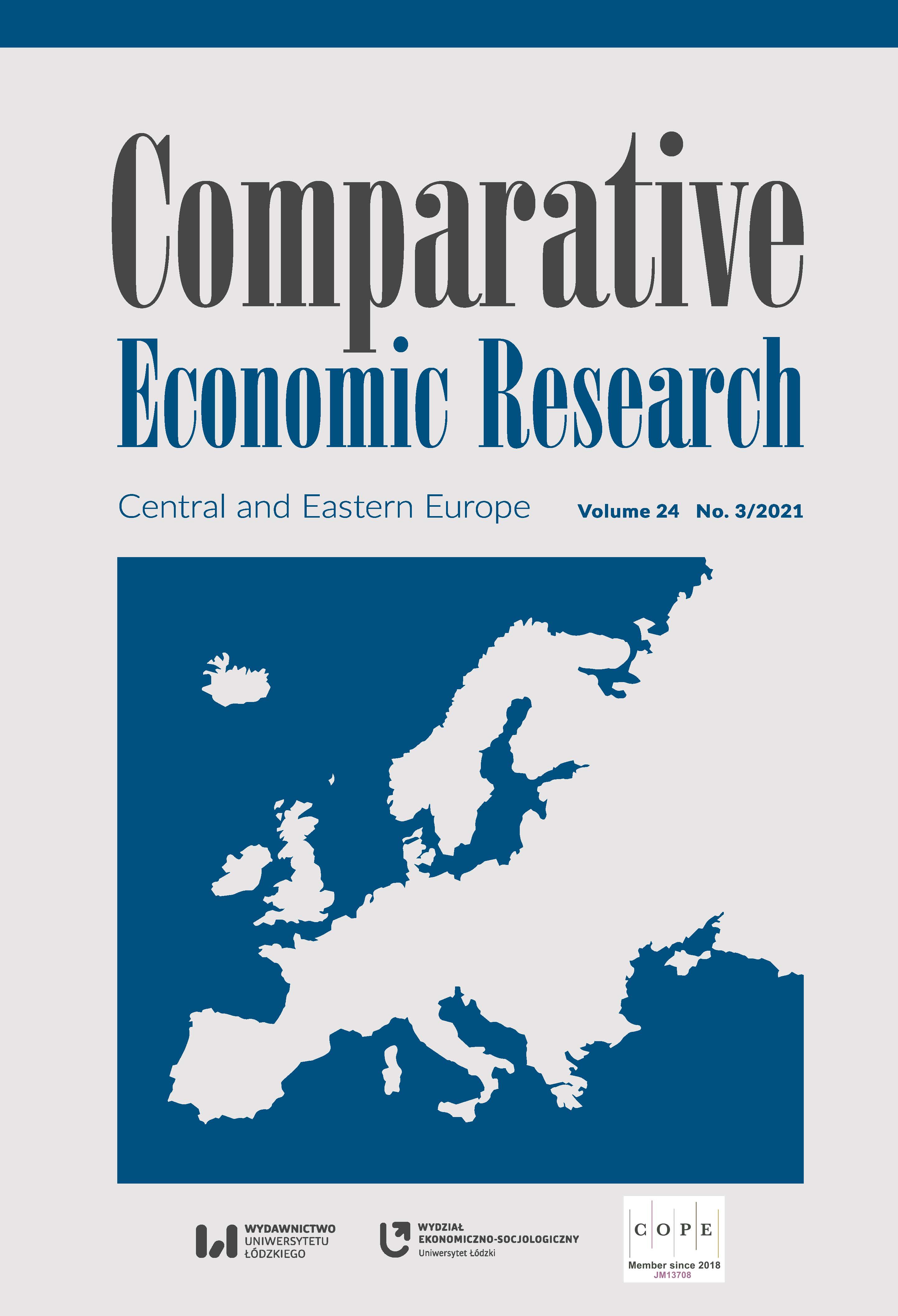Inequality and Students’ PISA 2018 Performance: a Cross-Country Study
DOI:
https://doi.org/10.18778/1508-2008.24.27Keywords:
education, gender inequality index, Gini index, inequality, PISA 2018Abstract
The aim of this paper was to investigate the relationship between countries’ PISA study results from 2018 and a set of indices related to socio-economic inequality, such as the Gini index, human development index, or gender inequality index, along with purely economic variables, such as GDP per capita and government expenditure on education. The study covered 70 countries, consisting of 37 OECD countries and 33 non-OECD countries. Research methods included multivariate linear regression models, k-means clustering, and hierarchical clustering. Our findings revealed that the Gini index was statistically insignificant, indicating income inequality had little effect on students’ PISA performance. On the other hand, the gender inequality index was the single most statistically significant explanatory variable for both OECD and non-OECD countries. Therefore, our recommendation for policymakers is simple: increase students’ PISA performance, thus enhancing countries’ human capital and competitiveness, and focus on decreasing gender disparity and the associated loss of achievement due to gender inequality.
Downloads
References
Afonso, A., Aubyn, M.S. (2005), Non-parametric Approaches to Education and Health Expenditure Efficiency in the OECD, “Journal of Applied Economics”, 8 (2), pp. 227–246, https://doi.org/10.1080/15140326.2005.12040626
Google Scholar
DOI: https://doi.org/10.1080/15140326.2005.12040626
Afonso, A., Aubyn, M.S. (2006), Cross-country efficiency of secondary education provision: a semi-parametric analysis with non‑discretionary inputs, “Economic Modeling”, 23 (3), pp. 476–491, https://doi.org/10.1016/j.econmod.2006.02.003
Google Scholar
DOI: https://doi.org/10.1016/j.econmod.2006.02.003
Agasisti, T. (2014), The Efficiency of Public Spending on Education: an empirical comparison of EU countries, “European Journal of Education”, 49 (4), pp. 543–557, https://doi.org/10.1111/ejed.12069
Google Scholar
DOI: https://doi.org/10.1111/ejed.12069
Aristovnik, A., Obadic, A. (2014), Measuring relative efficiency of secondary education in selected EU and OECD countries: the case of Slovenia and Croatia, “Technological and Economic Development of Economy”, 20 (3), pp. 419–433, https://doi.org/10.3846/20294913.2014.880085
Google Scholar
DOI: https://doi.org/10.3846/20294913.2014.880085
Aubyn, M.S., Pina, Á., Garcia, F., Pais, J. (2009), Study on the efficiency and effectiveness of public spending on tertiary education, “Economics Papers”, No. 390, European Committee, Brussels, https://doi.org/10.2765/30348
Google Scholar
Clements, B. (2002), How efficient is education spending in Europe?, “European Review of Economics and Finance”, 1 (1), pp. 3–26.
Google Scholar
DiCorrado, E., Kelly, K., Wright, M. (2015), The Relationship Between Mathematical Performance and GDP per Capita, https://smartech.gatech.edu/bitstream/handle/1853/54222/the_relationship_between_mathematical_performance_and_gdp_per_capita_1.bk-2.pdf (accessed: 10.02.2020).
Google Scholar
Duru-Bellat, M., Suchaut, B. (2005), Organisation and Context, Efficiency and Equity of Educational Systems: What PISA Tells Us, “European Educational Research Journal”, 4 (3), pp. 181–194, https://doi.org/10.2304/eerj.2005.4.3.3
Google Scholar
DOI: https://doi.org/10.2304/eerj.2005.4.3.3
Flores, I. (2017), Modelling efficiency in education: how are European countries spending their budgets and what relation between money and performance, “Sociologia, Problemas e Práticas”, 83, pp. 157–170, https://doi.org/10.7458/SPP2017836496
Google Scholar
DOI: https://doi.org/10.7458/SPP2017836496
French, J.J., French, A., Li, W.-X. (2015), The relationship among cultural dimensions, education expenditure, and PISA performance, “International Journal of Educational Development”, 42, pp. 25–34, https://doi.org/10.1016/j.ijedudev.2015.02.010
Google Scholar
DOI: https://doi.org/10.1016/j.ijedudev.2015.02.010
Gini, C. (1921), Measurement of Inequality of Incomes, “The Economic Journal”, 31 (121), pp. 124–126, https://doi.org/10.2307/2223319
Google Scholar
DOI: https://doi.org/10.2307/2223319
Hanushek, E.A. (1986), The economics of schooling: production and efficiency in the public schools, “Journal of Economic Literature”, 24 (3), pp. 1141–1178.
Google Scholar
Hanushek, E.A., Woessmann, L. (2011), The economics of international differences in educational achievement, [in:] E.A. Hanushek, S. Machin, L. Woessmann (eds.), Handbook of the Economics of Education, 3, North Holland, Amsterdam, pp. 89–200, https://doi.org/10.1016/B978-0-444-53429-3.00002-8
Google Scholar
DOI: https://doi.org/10.1016/B978-0-444-53429-3.00002-8
Kennedy, P. (2003), A Guide to Econometrics, 5th edition, MIT Press, Cambridge.
Google Scholar
Lockheed, M., Hanushek, E.A. (1994), Concepts of educational efficiency and effectiveness, “Human Resources Development and Operations Policy Working Papers”, No. HRO 24, World Bank, Washington.
Google Scholar
MacKay, D. (2003), An Example Inference Task: Clustering, [in:] D. MacKay, Information Theory, Inference and Learning Algorithms, Cambridge University Press, Cambridge, pp. 284–292.
Google Scholar
Mazurek, J., Mielcová, E. (2019), On the relationship between selected socio-economic indicators and student performances in the PISA 2015 study, “E+M”, 22 (2), pp. 22–39, https://doi.org/10.15240/tul/001/2019-2-002
Google Scholar
DOI: https://doi.org/10.15240/tul/001/2019-2-002
Miningou, E.W. (2019), Quality Education and the Efficiency of Public Expenditure: A Cross-Country Comparative Analysis, “Policy Research Working Paper”, 9077, pp. 1–22, https://doi.org/10.1596/1813-9450-9077
Google Scholar
DOI: https://doi.org/10.1596/1813-9450-9077
Nicoletti, C., Rabe, B. (2012), The effect of school resources on test scores in England, “Research Paper: Institute for Economic and Social Research”, https://www.iser.essex.ac.uk/publications/working-papers/iser/2012-13.pdf (accessed: 19.12.2019).
Google Scholar
Nielsen, F. (2016), Hierarchical Clustering, [in:] F. Nielsen, Introduction to HPC with MPI for Data Science, Springer, Cham, pp. 195–211.
Google Scholar
DOI: https://doi.org/10.1007/978-3-319-21903-5_8
O’Brien, R.M. (2007), A Caution Regarding Rules of Thumb for Variance Inflation Factors, “Quality and Quantity”, 41, pp. 673–690, https://doi.org/10.1007/s11135-006-9018-6
Google Scholar
DOI: https://doi.org/10.1007/s11135-006-9018-6
OECD (2019), PISA 2018 Results. Combined executive summaries. Volume I , II & III, https://www.oecd.org/pisa/Combined_Executive_Summaries_PISA_2018.pdf (accessed: 12.02.2020).
Google Scholar
Rosling, H., Rosling Ronnlund, A., Rosling, O. (2018), Factfulness: Reasons We’re Wrong About the World – and Why Things Are Better Than You Think, Flatiron Books, New York.
Google Scholar
United Nations Development Programme (2013), Technical notes, http://hdr.undp.org/sites/default/files/hdr_2013_en_technotes.pdf (accessed: 10.02.2020).
Google Scholar
United Nations Development Programme (2020), http://hdr.undp.org/en/2020-report (accessed: 10.02.2020).
Google Scholar
Wolff, E.N. (2015), Educational expenditures and student performance among OECD countries, “Structural Change and Economic Dynamics”, 33, pp. 37–57, https://doi.org/10.1016/j.strueco.2015.02.003
Google Scholar
DOI: https://doi.org/10.1016/j.strueco.2015.02.003
World Bank (2020), World Bank Open Data, https://data.worldbank.org/ (accessed: 11.02.2020).
Google Scholar
Yorulmaz, Y.I., Colak, I., Ekinci, C.E. (2017), An evaluation of PISA 2015 achievements of OECD countries within income distribution and education expenditures, “Turkish Journal of Education”, 6 (4), pp. 169–185, https://doi.org/10.19128/turje.329755
Google Scholar
DOI: https://doi.org/10.19128/turje.329755
Downloads
Published
How to Cite
Issue
Section
License

This work is licensed under a Creative Commons Attribution-NonCommercial-NoDerivatives 4.0 International License.











